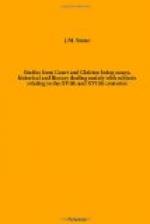Swift drew attention to the circumstance that Robert Harley was educated at Shilton, a private school in Oxfordshire, remarkable for having produced at the same time a Lord High Treasurer (the Earl of Oxford), a Lord High Chancellor (Lord Harcourt), a Lord Chief Justice of the Common Pleas (Lord Trevor), and ten members of the House of Commons, who were all contemporaries as well at school as in Parliament. From both his father and grandfather he had inherited a taste for books, and as Speaker of the House of Commons, had taken considerable part in organising the Cottonian library when it was bequeathed to the nation. It was on this occasion that his notice was first drawn to Humphrey Wanley, who offered some valuable hints in regard to the arrangement of the Cotton manuscripts, and subsequently proved himself to be the model of librarians.
Humphrey Wanley was the son of a country parson; he had received a university education, and had already achieved success and some fame as a scholar by his catalogue of the Anglo-Saxon MSS., preserved in the principal libraries of Great Britain. He would gladly have undertaken the custody of the Cotton library vice Dr. Smith, and wrote to Robert Nelson, a learned writer and philanthrophist, who apparently possessed some influence with the government, to solicit his good offices in procuring him that post. Nelson’s answer, interpolated by a remark in Wanley’s beautiful, scholarly hand, is interesting as an illustration of the rivalry that existed between the two foremost librarians of the day.
“Were I as able to advise Mr. Wanley as I am desirous to offer what might be most advantageous for his interest,” wrote Nelson, “I should immediately have answered your last letter which requires some queries to be resolved before I can well determine how you ought to proceed. For if there is any friendship between you and the Dr. [Smith] it will give a different aspect to your endeavours to supplant him.”
Here there is a mark in the original letter referring to a note written across the margin by Wanley as follows:
“This is about the Cottonian Library, the custody whereof I did then, and many years after, most ardently desire. As to friendship between Dr. Thomas Smith [here meant] and me there was but little, his conversation being not suitable to mine, by reason of his jealousies and peevishness extreme. I always allowed the Doctor’s pretensions to be much better grounded than mine; but if he, being a non-juror, could not swear to the Queen’s government, or being much in years should happen to decease, as he did after some time, I desired that employment when the trustees should please to regulate that noble collection.




